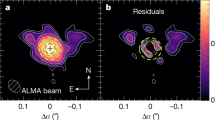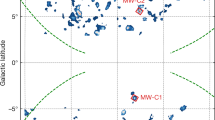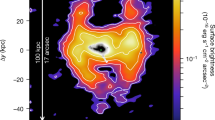Abstract
The interstellar medium is enriched primarily by matter ejected from old, evolved stars1,2. The outflows from these stars create spherical envelopes, which foster gas-phase chemistry3,4,5. The chemical complexity in circumstellar shells was originally thought to be dominated by the elemental carbon to oxygen ratio6. Observations have suggested that envelopes with more carbon than oxygen have a significantly greater abundance of molecules than their oxygen-rich analogues7. Here we report observations of molecules in the oxygen-rich shell of the red supergiant star VY Canis Majoris (VY CMa). A variety of unexpected chemical compounds have been identified, including NaCl, PN, HNC and HCO+. From the spectral line profiles, the molecules can be distinguished as arising from three distinct kinematic regions: a spherical outflow, a tightly collimated, blue-shifted expansion, and a directed, red-shifted flow. Certain species (SiO, PN and NaCl) exclusively trace the spherical flow, whereas HNC and sulphur-bearing molecules (amongst others) are selectively created in the two expansions, perhaps arising from shock waves. CO, HCN, CS and HCO+ exist in all three components. Despite the oxygen-rich environment, HCN seems to be as abundant as CO. These results suggest that oxygen-rich shells may be as chemically diverse as their carbon counterparts.
This is a preview of subscription content, access via your institution
Access options
Subscribe to this journal
Receive 51 print issues and online access
$199.00 per year
only $3.90 per issue
Buy this article
- Purchase on Springer Link
- Instant access to full article PDF
Prices may be subject to local taxes which are calculated during checkout



Similar content being viewed by others
References
Marvel, K. B. No methane here. The HCN puzzle: Searching for CH3OH and C2H in oxygen-rich stars. Astron. J. 130, 261–268 (2005)
Wilson, L. A. Mass loss from cool stars: Impact on the evolution of stars and stellar populations. Annu. Rev. Astron. Astrophys. 38, 573–611 (2000)
McCabe, E. M., Smith, R. C. & Clegg, R. E. S. Molecular abundances in IRC+10216. Nature 281, 263–266 (1979)
Glassgold, A. E. Circumstellar photochemistry. Annu. Rev. Astron. Astrophys. 34, 241–278 (1996)
Ziurys, L. M. The chemistry in circumstellar envelopes of evolved stars: Following the origin of the elements to the origin of life. Proc. Natl Acad. Sci. USA 103, 12274–12279 (2006)
Iben, I. & Renzini, A. Asymptotic giant branch evolution and beyond. Annu. Rev. Astron. Astrophys. 21, 271–342 (1983)
Oloffson, H. Molecules in envelopes around AGB-stars. Astrophys. Space Sci. 251, 31–39 (1997)
Cherchneff, I. A chemical study of the inner winds of asymptotic giant branch stars. Astron. Astrophys. 456, 1001–1012 (2006)
Anders, E. & Grevesse, N. Abundances of the elements: Meteoritic and solar. Geochim. Cosmochim. Acta 53, 197–214 (1989)
Duari, D., Cherchneff, I. & Willacy, K. Carbon molecules in the inner wind of the oxygen-rich Mira IK Tauri. Astron. Astrophys. 341, L47–L50 (1999)
Wallerstein, G. & Gonzalez, G. The spectrum of VY Canis Majoris in 2000 February. Publ. Astron. Soc. Pacif. 113, 954–956 (2001)
Smith, N. et al. The asymmetric nebula surrounding the extreme red supergiant VY Canis Majoris. Astron. J. 121, 1111–1125 (2001)
Sahai, R. & Wannier, P. G. SO and SO2 in mass-loss envelopes of red giants: Probes of nonequilibrium circumstellar chemistry and mass-loss rates. Astrophys. J. 394, 320–339 (1992)
Bowers, P. F., Johnston, K. J. & Spencer, J. H. Circumstellar envelope structure of late-type stars. Astrophys. J. 274, 733–754 (1983)
Muller, S. et al. The molecular envelope around the red supergiant VY CMa. Astrophys. J. 656, 1109–1120 (2007)
Kemper, F. et al. Mass loss and rotational CO emission from asymptotic giant branch stars. Astron. Astrophys. 407, 609–629 (2003)
Nercessian, E., Guilloteau, S., Omont, A. & Benayoun, J. J. HCN emission and nitrogen-bearing molecules in oxygen-rich circumstellar envelopes. Astron. Astrophys. 210, 225–235 (1989)
Humphreys, R. M., Davidson, K., Ruch, G. & Wallerstein, G. High-resolution, long-slit spectroscopy of VY Canis Majoris: The evidence for localized high mass loss events. Astron. J. 129, 492–510 (2005)
Smith, N. Spatially extended K I λ7699 emission in the nebula of VY CMa: kinematics and geometry. Mon. Not. R. Astron. Soc. 349, L31–L35 (2004)
Schwarzschild, M. On the scale of photospheric convection in red giants and supergiants. Astrophys. J. 195, 137–144 (1975)
Lim, J., Carilli, C. L., White, S. M., Beasley, A. J. & Marson, R. G. Large convective cells as the source of Betelgeuse’s extended atmosphere. Nature 392, 575–577 (1998)
Highberger, J. L., Thomson, K. J., Young, P. A., Arnett, D. & Ziurys, L. M. The salty scrambled egg: Detection of NaCl toward CRL 2688. Astrophys. J. 593, 393–401 (2003)
Cernicharo, J., Guelin, M. & Kahane, C. A λ2 mm molecular line survey of the C-star envelope IRC+10216. Astron. Astrophys. 142 (Suppl.). 181–215 (2000)
Szczerba, R., Schmidt, M. R. & Pulecka, M. Mixed chemistry phenomenon during late stages of stellar evolution. Balt. Astron. 16, 134–141 (2007)
Bujarrabal, V., Fuente, A. & Omont, A. Molecular observations of O- and C-rich circumstellar envelopes. Astron. Astrophys. 285, 247–271 (1994)
Schilke, P. et al. A study of HCN, HNC and their isotopomers in OMC-1. Astron. Astrophys. 256, 595–612 (1992)
Nejad, L. A. M. & Millar, T. J. Chemical modeling of molecular sources – VI. Carbon-bearing molecules in oxygen-rich circumstellar envelopes. Mon. Not. R. Astron. Soc. 230, 79–86 (1988)
Zubko, V., Li, D., Lim, T., Feuchtgruber, H. & Harwit, M. Observations of water vapour outflow from NML Cygnus. Astrophys. J. 610, 427–435 (2004)
Monnier, J. D., Danchi, W. C., Hale, D. S., Tuthill, P. G. & Townes, C. H. Mid-infrared interferometry on spectral lines. III. Ammonia and silane around IRC+10216 and VY Canis Majoris. Astrophys. J. 543, 868–879 (2000)
Lauria, E. F. et al. First Astronomical Observations with an ALMA Band 6 (211–275 GHz) Sideband-Separating SIS Mixer-preamp (ALMA Memo No. 553); 〈www.alma.nrao.edu/memos/〉 (2006)
Acknowledgements
We thank the National Radio Astronomy Observatory for the loan of the ALMA Band 6 mixer system, and A. Lichtenberger and the University of Virginia Microfabrication Laboratory for supplying the mixer junctions. This research is partly supported by the NSF Astronomy and NASA Astrobiology programmes.
Author information
Authors and Affiliations
Corresponding author
Ethics declarations
Competing interests
Reprints and permissions information is available at www.nature.com/reprints. The authors declare no competing financial interests.
Supplementary information
Supplementary Information 1
This file contains Supplementary Discussion with a brief description of the model employed for molecular abundance derivations and additional references. (PDF 187 kb)
Rights and permissions
About this article
Cite this article
Ziurys, L., Milam, S., Apponi, A. et al. Chemical complexity in the winds of the oxygen-rich supergiant star VY Canis Majoris. Nature 447, 1094–1097 (2007). https://doi.org/10.1038/nature05905
Received:
Accepted:
Published:
Issue Date:
DOI: https://doi.org/10.1038/nature05905
This article is cited by
-
Molecular properties of the PCO radical: heat of formation and the isomerization pathways
Journal of Molecular Modeling (2014)
-
The infrared spectral features of circumstellar envelope of evolved low- and intermediate-mass stars
Science in China Series G: Physics, Mechanics and Astronomy (2008)
-
A new molecular factory
Nature (2007)
Comments
By submitting a comment you agree to abide by our Terms and Community Guidelines. If you find something abusive or that does not comply with our terms or guidelines please flag it as inappropriate.



